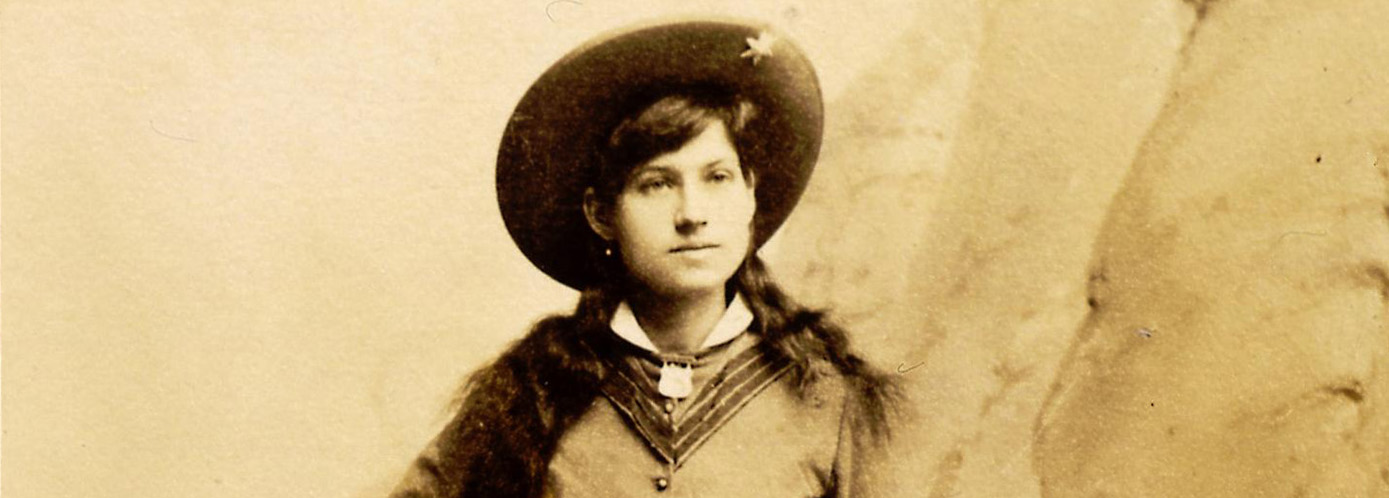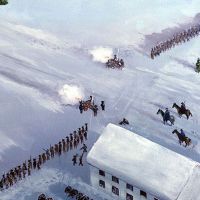Annie Oakley Purchases Smith & Wesson Gun
On this day in 1888, Annie Oakley, the star female sharpshooter in Buffalo Bill Cody's Wild West Show, purchased a Model 3 handgun made by the Springfield firm of Smith & Wesson. Horace Smith and Daniel B. Wesson had joined forces in the 1850s and opened a factory in Springfield to produce a revolutionary type of gun and ammunition. Their design pioneered the use of sealed cartridges for quick-loading and rapid-firing. The company continued to innovate, introducing the Model 3, which became a favorite of the U.S. cavalry, cowboys, and European soldiers; the 38 revolver, carried by policemen all over the world; and the Magnum made famous by Clint Eastwood in the movie "Dirty Harry."
Carried by police in virtually every city in the world, it has never been out of production.
When Annie Oakley was looking for a top-quality handgun to use in her Wild West sharpshooting act, she chose one made in Springfield, Massachusetts — the world-famous Smith & Wesson Model 3. Horace Smith, a Springfield toolmaker, and Daniel Wesson, a gunsmith from Northborough, had combined their skills and ingenuity in 1852 to invent a gun with a self-contained cartridge. For the first time, a person could reload a firearm without first mixing loose gunpowder, balls, and primer.
After several years of contending with rival patents and a shortage of capital, Smith & Wesson emerged as one of the world's most successful — and famous — gun-making firms, the choice of generals, law enforcement officials, western gunslingers, and rodeo performers such as Annie Oakley. It made perfect sense to locate the company in the nation's oldest and most fabled armory town, Springfield, Massachusetts.
During the early years of the Revolution, General George Washington had chosen Springfield to be the site of the new nation's first arsenal. In 1794 then-President Washington expanded the arsenal into the United States' first armory. Springfield became a center of innovation and a magnet for entrepreneurs in the arms industry.
Horace Smith was a toolmaker who had learned gunsmithing on the job at the Springfield Armory. Daniel B. Wesson had been an apprentice in his brother's gun shop. In 1850 Wesson's brother died; at 25, Daniel took over the shop and began making the Wesson hunting rifle.
It made perfect sense to locate the company in the nation's oldest and most fabled armory town, Springfield, Massachusetts.
Smith and Wesson joined forces two years later. Like many innovators, they set out to solve a problem. Guns still used ammunition that had to be mixed and loaded on the spot, a slow and painstaking process. According to Revolutionary-era manuals, it took as many as 24 steps to reload, prime, and fire a musket. Gunpowder was easily spoiled by moisture. Smith and Wesson devised a sealed, self-contained waterproof cartridge and a lever-action pistol to fire it.
The idea was revolutionary. According to one historian, it "moved firearms out of the muzzleloading era that had dominated the industry since the invention of the hand cannon in the fourteenth century." In 1852, the pair opened their first factory in Norwich, Connecticut, where they produced a repeater rifle that used the new cartridge. Called the "Volcanic" because of its tremendous firepower and rapid-fire capability, the rifle was intended as a rival to the popular new Colt revolver. It did not function or sell as well as Smith and Wesson had hoped, and they had difficulty raising enough capital to make the needed improvements. They were forced to sell the Norwich factory and the patent on the "Volcanic" to Oliver Winchester, who in turned established the successful Winchester Repeating Arms Company.
Horace Smith and Daniel Wesson were disappointed but not deterred. Smith returned to Springfield, while Wesson remained as supervisor of the Winchester plant. While there, he designed a small revolver that could shoot the self-contained ammunition cartridge that he and Smith had patented earlier in the year.
According to Revolutionary-era manuals, it took as many as 24 steps to reload, prime, and fire a musket.
In 1856 they regrouped in Springfield and opened a new factory to produce the revolver Wesson had designed. The world's first fully-contained cartridge revolver, Model One was immediately popular, and demand soon outstripped the factory's output. Once patents were secured and a new factory built, the pair found themselves the proprietors of a very lucrative business. Their timing was fortuitous, too, as the Civil War spurred demand for small weapons.
In the years right after the Civil War, an economic downturn caused a steep drop-off in the demand for firearms. Smith and Wesson were aware that their patents were about to expire and that they needed to continue innovating to remain competitive. They could see that a market was developing for guns that would appeal to both cavalrymen and cowboys on the western frontier. In 1869 they developed the Smith & Wesson "Model 3 American," the world's first large caliber cartridge revolver. A special feature allowed mounted soldiers to reload "on the fly." One of the company's biggest customers was the U.S. Cavalry.
The fast-loading Smith & Wesson Model 3 was enormously successful. A rival to the popular Colt revolver, it played a legendary role in the "Wild West." Frank and Jesse James, Buffalo Bill Cody, Annie Oakley, Theodore Roosevelt, Virgil Earp, and a variety of lawmen, outlaws, and rodeo stars all used it.
Smith & Wesson also marketed its guns overseas, demonstrating them at major expositions in Paris and other cities. The displays highlighted not just the gun's capabilities, but also the fine engraving that showed the high quality of the firm's craftsmanship. The Russian Grand Duke Alexis was so impressed that he purchased several pistols for himself and his aides. At his urging, in 1871, the Russian government placed an order for 20,000 Model 3 revolvers. Worldwide demand was so strong that the plant could not keep up with orders.
Frank and Jesse James, Buffalo Bill Cody, Annie Oakley, Theodore Roosevelt, Virgil Earp, and a variety of lawmen, outlaws, and rodeo stars all used it.
Horace Smith retired in the 1870s, and Wesson's sons joined the company, which kept the name Smith & Wesson. The firm continued to innovate and to dominate the market for small arms. In the late 1800s it introduced what may be the world's most ubiquitous gun — the .38 Military and Police Model 10. Carried by police in virtually every city in the world, it has never been out of production.
In 1935 the company produced the first Magnum revolver. When F.B.I. director J. Edgar Hoover received one from the company, he ordered the model for all his agents. Twenty years later Smith & Wesson pioneered the first American-made double-action auto-loading pistol, the .44 Magnum. The later generation of Magnums became the most popular revolvers ever made.
Smith & Wesson has experienced a number of changes in ownership and management, but the company continues its tradition of innovation and craftsmanship. At its increasingly high tech factory in Springfield, each and every handgun is still fitted and checked by a skilled assembly worker and then test fired.
Location
This Mass Moment occurred in the Western region of Massachusetts.


Sources
Boston Globe January 6, 2005.
Smith & Wesson, 1857-1945, by Roy G. Jinks. (S.A. Barnes, 1975)
History of Smith & Wesson Firearms, by Dean K. Boorman (Lyons Press, 2002)
History of Smith & Wesson: No Thing of Importance Will Come without Effort, by Roy G. Jinks (Beinfeld Publishers, 1977).




